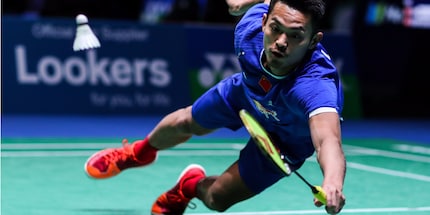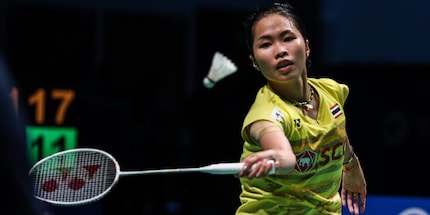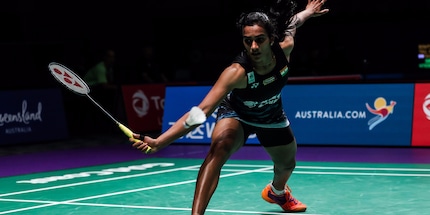
Which badminton racket do I need? The expert knows the answer
Head or handle, aluminium or graphite, light or heavy - choosing the right badminton racket is not easy. We would like to make the decision a little easier for you and have interviewed Thomas Münzner. He is Co-Managing Director of Yonex in Switzerland. Yonex is a leading Japanese badminton brand in Switzerland and worldwide. You can find Thomas' answers here.
How do I find the right badminton racket for me?
Badminton rackets, like many products in the industry, are generally speaking - the more expensive, the better. Similar to cars. Only, fortunately, they cost much less than cars, namely a maximum of around 300 francs. So first of all, you should ask yourself how much money you want to spend on your new badminton racket. You can roughly divide the rackets on the market into three price categories:
- 20 to 100 francs: Here you are primarily paying to reduce the weight. The cheapest rackets are made of steel, followed by aluminium. Graphite is added from 50 francs. Today, you can buy a good full graphite racket made from one piece (so-called one-piece construction) for around 90 francs. Such a racquet weighs around 80 to 90g and is therefore just as light as the vast majority of more expensive racquets.
- 100 to 200 francs: The use of graphite means that this is a good weight for a badminton racket. So that's hardly a criterion anymore. What comes into play now are technologies and different types of rackets that cater to the individual wishes of the player(s).
- 200 to 300 francs: The rackets in this price category are top rackets that are also used by professionals. The great thing about these rackets is that they are also suitable for beginners. Because they make playing badminton easier, at any level. What's included in this price range: clever ideas from high technology, e.g. from nanotechnology, improved material, improved aerodynamics and much more.

And apart from the price - what should I look out for when buying?
The price is certainly a pretty good point of reference for orientation. Another criterion is quality. Unfortunately, you can hardly judge this when you see a picture of the racket on your computer or when you hold one in your hand in the shop. You only realise this when you play. However, a high price is generally an indicator of good quality. Incidentally, Yonex rackets are often counterfeited and sold at ridiculously low prices. Super-cheap top rackets are always fakes. I therefore naturally recommend buying the racket in Switzerland.
Are there special rackets for beginners, advanced players and professionals?
No, there are not. As I said, a better racquet always makes for a better game. It's like cycling: A professional weighing 60kg will ride up a hill much faster on a 7kg bike for 10,000 francs than on a 12kg göppel for 500 francs. But even a beginner weighing 90kg will ride uphill faster on a lightweight bike, won't they? So: the better the racquet, the more fun you'll have playing! No matter what level of play.
What does head/handle-heavy mean?
Well, in badminton, being able to hit the shuttle hard is pretty central. Anyone who has ever played badminton knows this. Just hitting from baseline to baseline requires a lot of power and technique. To your question: "Top-heavy" means that the head (compared to the handle) of the racket is heavier, for example because some metal has been incorporated. If you now make a long stroke with a head-heavy racquet, such as a smash where you have a lot of time to swing, you can increase the weight in the racquet head (for physicists: lever law) onto the shuttle and hit hard. The problem, however, is that the heavy racket head takes some time to react to a short stroke (law of inertia).
And with the grip-heavy racquet it's the other way round?
Exactly! A grip-heavy racquet is weaker on smashes, but faster on short movements out of the hand. And as a compromise, there are balanced racquets. So you can't say that you can hit harder with one racquet or another. No, it depends on the swinging motion. And the technique. And again, the level of play doesn't matter.

Yonex, for example, has different racket lines such as Voltric, Arc Saber, Duora or Nanoray. What makes them different?
Yonex decided a long time ago to use the above-mentioned weight of badminton rackets as a criterion to define and differentiate the racket series. All Voltric are head heavy, all Arc Saber and all Duora balanced, and all Nanoray handle-heavy.
By the way: Another important distinguishing feature (within each series) is the frame hardness of a racket. Hard rackets are good for a precise game, but the power has to come from the player. Soft rackets have more power, but you always have to compromise on precision. So there is always a trade-off between power and precision.
Ok, but which racket should I actually buy when I'm sitting in front of the screen, looking at the huge range on sale and have no clue?
Fundamentally, you shouldn't ask yourself what type of player you are. But what you expect from your racquet. There are 3 questions to ask yourself for now:
- Question 1: Do you want power when you have time to hit, or power when you don't? Or a compromise? Answer Power with time: Top-heavy racquets, e.g. the Yonex Voltric series. Answer Power without time: Grip-heavy rackets, e.g. the Yonex Nanoray series. Answer Compromise: Balanced rackets, e.g. the Yonex Arc Saber or Duora series.
- Question 2: Do you basically want power or precision? Or a compromise? Answer Power: Soft rackets from the series you chose in question 1. Answer Precision: Hard rackets from the series you chose in question 1. Answer Compromise: Medium-hard rackets from the series you chose in question 1
- Question 3: How much do you want to pay? Here you need to find a racket that fits your first 2 answers and your budget. For those who are undecided, I recommend at least a full carbon racket like the Isometric Lite 3. It is very light for the price and well balanced: It's a good racquet at a reasonable price.
Of course, design can also play a role when choosing a racket. Or other criteria. But the crucial three questions you should ask yourself are the three mentioned above. If you choose well, you'll have a lot of fun playing badminton.

What about the stringing?
Many people think that a hard string makes a hard smash. In fact, it's the other way round! For comparison: a soft trampoline lets you jump high, not a hard one, right? Incidentally, all Yonex badminton rackets are strung. Our factory strings always weigh around 9kg. If you restring a racket, you can influence this. Again, harder gives more precision, softer gives more power. Professionals string with up to 15 kg, but I don't recommend this at all for mere mortals. Because if you don't hit the shuttle well in the centre of the string with such a racquet, little or nothing will happen.
Ok, the string hardness is clear, but what about the string itself?
Badminton strings are all multifilament, i.e. made up of many individual threads, and tend to be designed for power. There are no monofilament strings made of polyester, as in tennis. There is a large selection of strings, but in general you can say: thicker strings last longer, thinner strings have more tension but last less. At Yonex, the factory string for the higher-priced racquets is BG68ti, a titanium-reinforced, rather thin string in white.
You also play, of course, with which racket?
Of course, almost every day! And I still enjoy it as much as I did on the first day. My racquet is the Yonex Nanoray 800. It's hard and grippy, so it's precise and fast when you need to move quickly - great! By the way: The Badminton World Championships start in Glasgow on 21 August, check it out on YouTube!
Interesting facts about products, behind-the-scenes looks at manufacturers and deep-dives on interesting people.
Show all